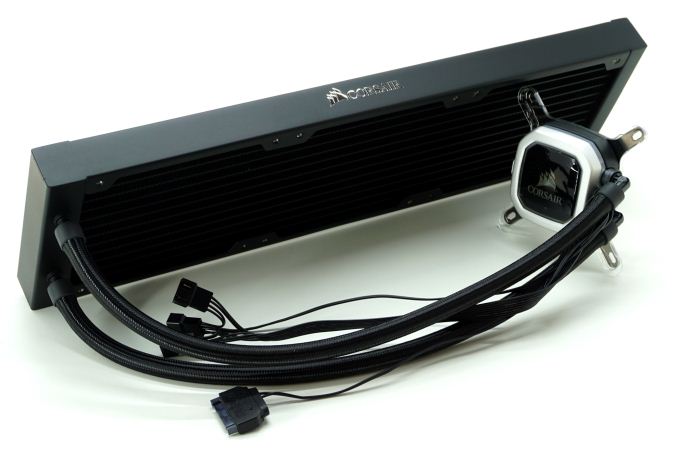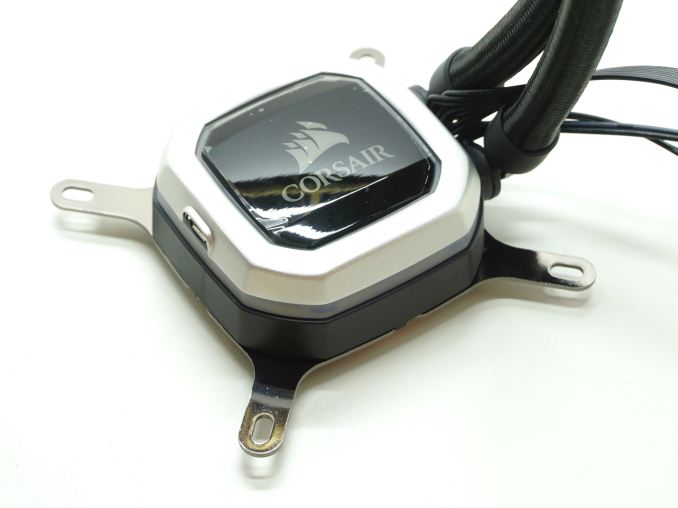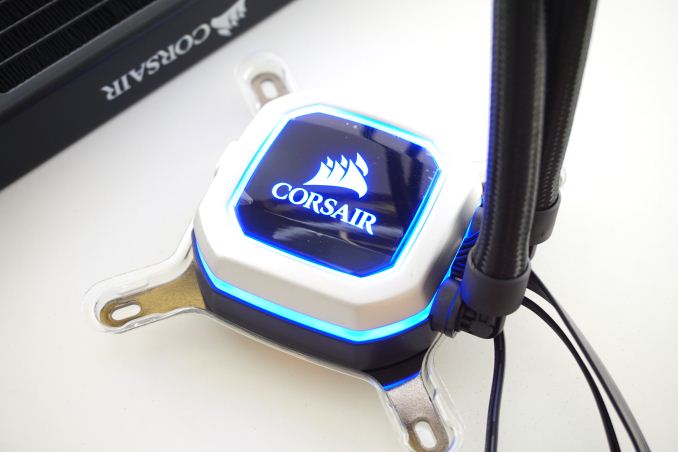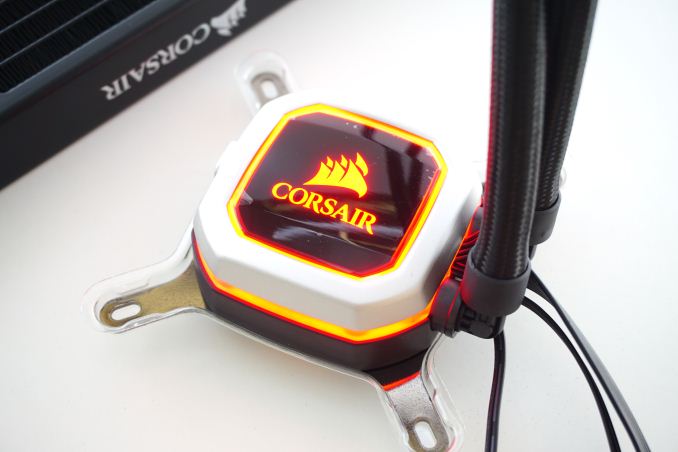The Corsair H150i Pro RGB AIO Cooler Review: The Quiet Giant
by E. Fylladitakis on August 16, 2018 8:00 AM ESTThe Corsair H150i Pro RGB
A single look at the H150i Pro RGB reveals how massive the cooler is. The radiator is so large that the hoses are not long enough for the block to reach its other end. The overall design is based on the common AIO cooler configuration of a single radiator, two hoses, and a single block that combines the copper CPU contact plate with a mini liquid pump. Such designs are usually using stiff corrugated tubing to prevent kinking but not this one, as Corsair went with thick-walled FEP (Fluorinated Ethylene Propylene) tubing with nylon sleeve braiding, which is more flexible and aesthetically superior.
Corsair designed the H150i Pro RGB to hold three consecutive 120 mm fans but the radiator itself is 400 mm long, requiring a case designed not only to hold three 120 mm fan in the row but also with enough space to fit a liquid cooling radiator. The massive radiator is a classic dual pass cross-flow design with tiny fins soldered on the thin oblong tubes. Despite its massive length, the radiator of the H150i Pro RGB is not actually very thick. It is just 27 mm thick, meaning that a total clearance of at least 55 mm is required using the stock 120 mm fans and taking into account the 3 mm screw heads. It is obvious that the designer of the H150i Pro RGB intended it to be usable with low speed fans, so the airflow resistance of the radiator had to be kept low.
The main block assembly of the H150i Pro RGB is jestingly small when compared to the massive size of its radiator. It is a very small assembly by any comparison, considerably shorter than the vast majority of AIO blocks that we have seen to this date. Most of the assembly is made out of plastic, with an octagonal body and a circular base. A silver frame surrounds the piano-black top with the company's logo. The rest of the plastic body is black, with chromed metallic parts. The block is powered via a SATA connector and has a 3-pin motherboard connector that serves only as a tachometer for speed/health monitoring. A flat cable that ends to three fan connectors also exits the block, for the power, monitoring, and control of the three radiator fans.
The copper contact plate is attached to the circular base of the block with eight screws. Although it is not machined to a perfect mirror finish, it is very smooth and perfectly flat, which is what matters for good thermal performance. Thermal material is applied to it and it comes with the Intel CPU mounting retention bracket from the factory. A retention bracket for AMD CPUs is included in the bundle. There was no bracket for AMD's Ryzen Threadripper processors inside the box of our sample but Corsair now mentions that the H150i Pro RGB does support AMD's Ryzen Threadripper processors, plus an extra TR4 mounting bracket part appeared in their website.
Corsair installed RGB lighting into the block. Once the H150i Pro RGB is powered, the company's logo and a ring surrounding the block will illuminate. The lighting colour and effects are programmable via Corsair's iCUE software if the USB cable is connected to one of the motherboard's internal USB 2.0 headers.
The new iCUE software is very flexible and allows for the interconnection of any compatible device, inside and outside the case. It is also possible to program the lighting colors to have a practical meaning, such as programming variable lighting colors for different CPU (or other) temperature readings. For example, you can set your Corsair K95 Platinum's keyboard lighting to blink red if the processor's temperature surpasses a certain point while, and even have the computer shut down if the temperature is sustained above a threshold for X seconds.























42 Comments
View All Comments
Wolfclaw - Friday, August 17, 2018 - link
I'll stick to my Arctic 240 with its 4 fans, £75 and keeps my R5-2600 cool and quiet !imaheadcase - Friday, August 17, 2018 - link
I'm actually surprised Intel and AMD just don't ship small water AIO with retail cpu by now. I guess they are still afraid of the old "it has water it can mess stuff up" mentality.Oxford Guy - Friday, August 17, 2018 - link
AMD did that with the 9590.Icehawk - Saturday, August 18, 2018 - link
I believe Intel also offered them at one point - not very good ones though.Orange_Swan - Tuesday, August 21, 2018 - link
to be fair with a 225w tdp it was probably cheaper than building a comparable air coolernpp - Friday, August 17, 2018 - link
"The noise floor of our recording equipment is 30.2-30.4 dB(A), which represents a medium-sized room without any active noise sources."This is false and misleading, as is the whole table stating among others that anything below 35dBa is "virtually inaudible".
Really sad that silentpcreview.com is gone now, as are the days when such dubious and downright erroneous statements wouldn't have made their way into an anandtech review.
Oxford Guy - Friday, August 17, 2018 - link
My favorite example is when the same review site that glosses over fan noise later gushes about the silence afforded by a fanless PC. Which is it? Either all those fans are "silent" and "inaudible" or they're not.Tell a tinnitus sufferer about silent PC fans. It is, for instance, very possible for a person to be able to tolerate many, much louder, sounds — like air conditioner fans and car trip noise, and yet get much worse tinnitus reaction problems from these supposedly silent/quiet/inaudible PC parts.
I've been waiting many years for a high-performance fanless case but it looks like the lastest one, the Calyos, is vaporware. Apparently, the designers have moved to a new startup to create more vaporware, albeit with worse specs.
Ryan Smith - Friday, August 17, 2018 - link
So the standard that is usually quoted for a quiet room in a rural area is 30 dB(A).http://www.dot.ca.gov/dist2/projects/sixer/loud.pd...
In practice you won't find that rooms can get much quieter than that without using sound-absorbing designs, be it a recording studio or anechoic chamber.
Now if you have findings that say otherwise, we're more than happy to look at them. After all, we strive for accuracy. But what I can say for certainty is that none of our testing environments get below 30 dB(A).
npp - Friday, August 17, 2018 - link
Ryan, this a review of the legendary Scythe Ninja done by SPCR in 2005, long before they built their hemi-anechoic chamber:https://bit.ly/2MA3g5E
As you can see, the ambient SPL was 18dBA (without room treatment) and the fan did rise up to about 22dBA, which according to the quoted data should be inaudible. Of course, if the noise floor in the room is 30dBa, one could go on and state that the cooler is silent, and this wouldn't be true.
I'm not trying to argue or split hairs here, but if you want to include SPL measurements, you should take them more seriously. A room with 30dBa noise floor isn't the best place to perform such measurements to begin with and makes judgement of the sound performance of various fans highly unreliable.
Now regarding what constitutes a quite room, this is really a subjective matter. The common consensus is around 20-30dBA, I personally would call 20dBa quite enough.
Diji1 - Friday, August 17, 2018 - link
>A room with 30dBa noise floor isn't the best place to perform such measurementsFair point but it's not as though most users are going to be using the product in super quiet spaces like that.